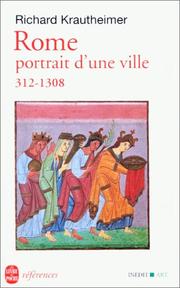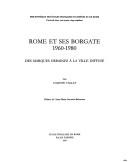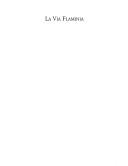| Listing 1 - 7 of 7 |
Sort by
|
Book
ISBN: 8885978029 Year: 1992 Publisher: Sant'Oreste Apeiron
Abstract | Keywords | Export | Availability | Bookmark
 Loading...
Loading...Choose an application
- Reference Manager
- EndNote
- RefWorks (Direct export to RefWorks)

ISBN: 2253905623 9782253905622 Year: 1999 Volume: 562 Publisher: Paris Le livre de poche
Abstract | Keywords | Export | Availability | Bookmark
 Loading...
Loading...Choose an application
- Reference Manager
- EndNote
- RefWorks (Direct export to RefWorks)
L'auteur de l'ouvrage étudie l'histoire de l'urbanisme de la ville de Rome à une époque la plus méconnue de son histoire. Cette période s'étend du règne de Constantin aux papes d'Avignon. Il crée des liens entre la topographie, la politique, la liturgie et l'architecture
Architecture --- Rome (City) --- Rome (Italy) --- Rome (Italie) --- History --- Histoire --- Histoire de l'urbanisme --- Histoire des villes --- Christianisme --- Histoire de l'art --- Rome --- #gsdb8 --- #GOSA:XI.Oud.M --- 945.632 --- History Italy Rome --- Roma --- Moyen Age

ISBN: 2728303282 9782728303281 Year: 1995 Volume: 287 Publisher: Roma : Ecole française de Rome,
Abstract | Keywords | Export | Availability | Bookmark
 Loading...
Loading...Choose an application
- Reference Manager
- EndNote
- RefWorks (Direct export to RefWorks)
Housing --- Slums --- Suburbs --- Italy --- Rome --- -Slums --- -Suburbs --- -945.632 --- Outskirts of cities --- Suburban areas --- Suburbia --- Cities and towns --- City planning --- Metropolitan areas --- Slum clearance --- Affordable housing --- Homes --- Houses --- Housing needs --- Residences --- Urban housing --- Dwellings --- Human settlements --- -Rome --- History Italy Rome --- Growth --- Social aspects --- Rome (Italy) --- -Rome Suburban Area (Italy) --- Population --- 945.632 --- Rome Suburban Area (Italy). --- Rome (Italy : Commune) --- Rome (Italy : Governatorato) --- Rūmah (Italy) --- Roma (Italy) --- Rom (Italy) --- Rím (Italy) --- Rzym (Italy) --- Comune di Roma (Italy) --- Population. --- Rome. --- Buildings, structures, etc. --- Urbanization --- Rome (Italy : Comune) --- Suburbs - Italy - Rome. --- Slums - Italy - Rome. --- Housing - Italy - Rome. --- Rome (italie) --- Urbanisme
Book
ISBN: 9789058264664 9058264661 Year: 2007 Publisher: Leuven Davidsfonds
Abstract | Keywords | Export | Availability | Bookmark
 Loading...
Loading...Choose an application
- Reference Manager
- EndNote
- RefWorks (Direct export to RefWorks)
Regional documentation --- Rome --- C3 --- wandelgids --- Roma [gemeente in provincie Roma - IT] --- iconografisch materiaal --- Vlaams Gewest [gewest in land België - BE] --- 910.202 --- 945.632 --- Kunst en cultuur --- History General geography Travel World travel guides --- History Italy Rome --- History --- Description and travel

ISBN: 8871400399 Year: 1991 Publisher: Roma Quasar
Abstract | Keywords | Export | Availability | Bookmark
 Loading...
Loading...Choose an application
- Reference Manager
- EndNote
- RefWorks (Direct export to RefWorks)
Excavations (Archaeology) --- Roads, Roman --- Fouilles (Archéologie) --- Voies romaines --- Via Flaminia (Italy) --- Rome --- Via Flaminia (Italie) --- Antiquities --- Antiquités --- 914.5632 --- 945.632 --- History General Geography and travel Italy Latium region Rome --- History Italy Rome --- Flaminia, Via (Italy) --- Fouilles (Archéologie) --- Antiquités
Book
ISBN: 3700101511 9783700101512 Year: 1976 Publisher: Wien Österreichische Akademie der Wissenschaften
Abstract | Keywords | Export | Availability | Bookmark
 Loading...
Loading...Choose an application
- Reference Manager
- EndNote
- RefWorks (Direct export to RefWorks)
Church and state --- Catholic Church --- History --- Rome (Italy) --- Papal States --- -945.632 --- Christianity and state --- Separation of church and state --- State and church --- State, The --- History Italy Rome --- -Church of Rome --- Roman Catholic Church --- Katholische Kirche --- Katolyt︠s︡ʹka t︠s︡erkva --- Römisch-Katholische Kirche --- Römische Kirche --- Ecclesia Catholica --- Eglise catholique --- Eglise catholique-romaine --- Katolicheskai︠a︡ t︠s︡erkovʹ --- Chiesa cattolica --- Iglesia Católica --- Kościół Katolicki --- Katolicki Kościół --- Kościół Rzymskokatolicki --- Nihon Katorikku Kyōkai --- Katholikē Ekklēsia --- Gereja Katolik --- Kenesiyah ha-Ḳatolit --- Kanisa Katoliki --- כנסיה הקתולית --- כנסייה הקתולית --- 가톨릭교 --- 천주교 --- -Papal States --- -Rome (Italy) --- -History --- 945.632 --- History. --- Church of Rome --- Church and state - Europe --- Rome (Italy) - History --- Papal States - History

ISBN: 9004148930 904741795X 9789047417958 9789004148932 Year: 2005 Volume: 135 Publisher: Brill
Abstract | Keywords | Export | Availability | Bookmark
 Loading...
Loading...Choose an application
- Reference Manager
- EndNote
- RefWorks (Direct export to RefWorks)
In ten chapters, partly case-studies, this monograph analyzes the (new) ways in which cultural manifestations were used to create the necessary preconditions for (religious) policy and power in the Rome of Urban VIII (1623-1644). It was the intensified interaction between culture and power-politics that created what we now call ‘the Baroque’. Based on a rich variety of, hitherto largely unexplored, primary sources, the book addresses the basic issues of papal power in the post-Tridentine period. It does not study actual papal politics, but rather the cultural forms that were essential to the representation and legitimatization of the papacy’s power, both secular and religious and that (co-)determined the effectiveness of papal policy. Precisely during Urban’s long pontificate, the manifold, always imaginative and often unexpected uses of power representation became, in the end, not so much a series of cultural forms as, in a sense, the structure of early modern (Roman) society.
Papacy --- 945.07 --- 945.632 --- History --- History Italy 1527 - 1796 --- History Italy Rome --- Urban --- Barberini, Francesco, --- Barberino, Francesco, --- Barberinus, Franciscus, --- Barberini, Maffeo, --- Urbano --- Urbanus --- Rome (Italy) --- Rome (Italy : Commune) --- Rome (Italy : Governatorato) --- Rūmah (Italy) --- Roma (Italy) --- Rom (Italy) --- Rím (Italy) --- Rzym (Italy) --- Comune di Roma (Italy) --- Rome --- Civilization --- popes --- church history --- Urban VIII [Pope] --- Religion and culture --- Religion et culture --- Histoire --- Barberini family --- Art patronage. --- Rome (Italie) --- Civilisation --- Barberini, Maffeo Vincenzo, --- Barberino, Maffeo, --- Christian influences --- Rim --- Roman Empire --- Roman Republic (510-30 B.C.) --- Romi (Empire) --- Byzantine Empire --- Urbain --- Rome (Italy : Comune) --- Papacy - History - 1566-1799. --- Urbain VIII, --- Early Modern History --- Cardinal (Catholic Church) --- Gigli --- Pope --- Vatican Library
| Listing 1 - 7 of 7 |
Sort by
|

 Search
Search Feedback
Feedback About
About Help
Help News
News